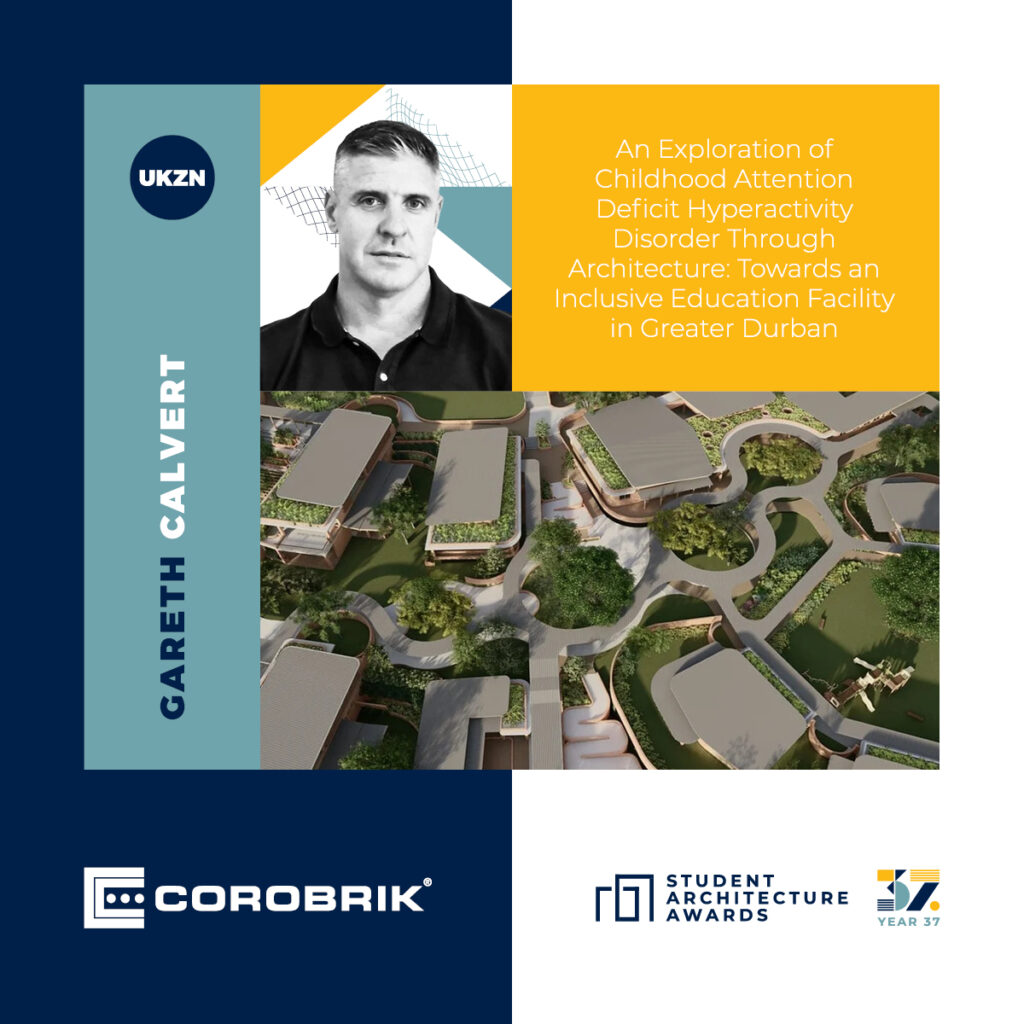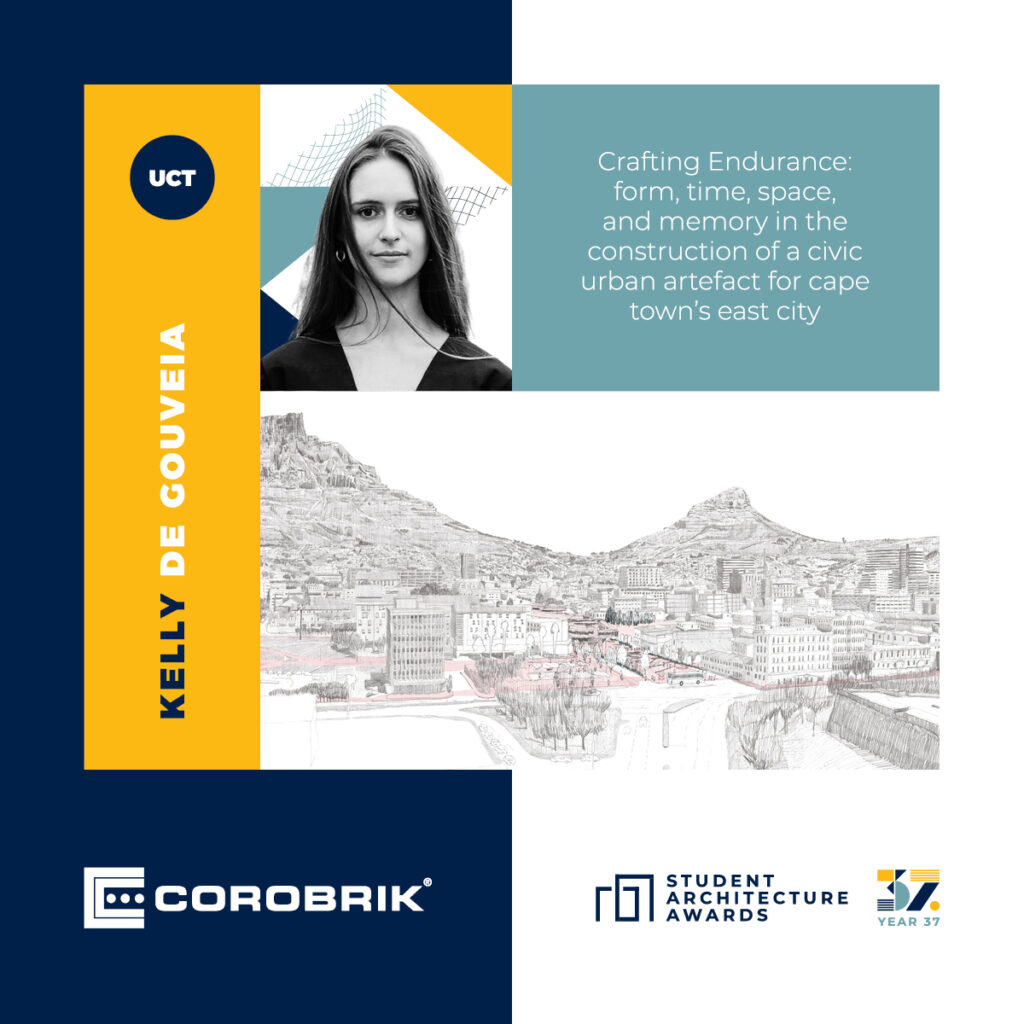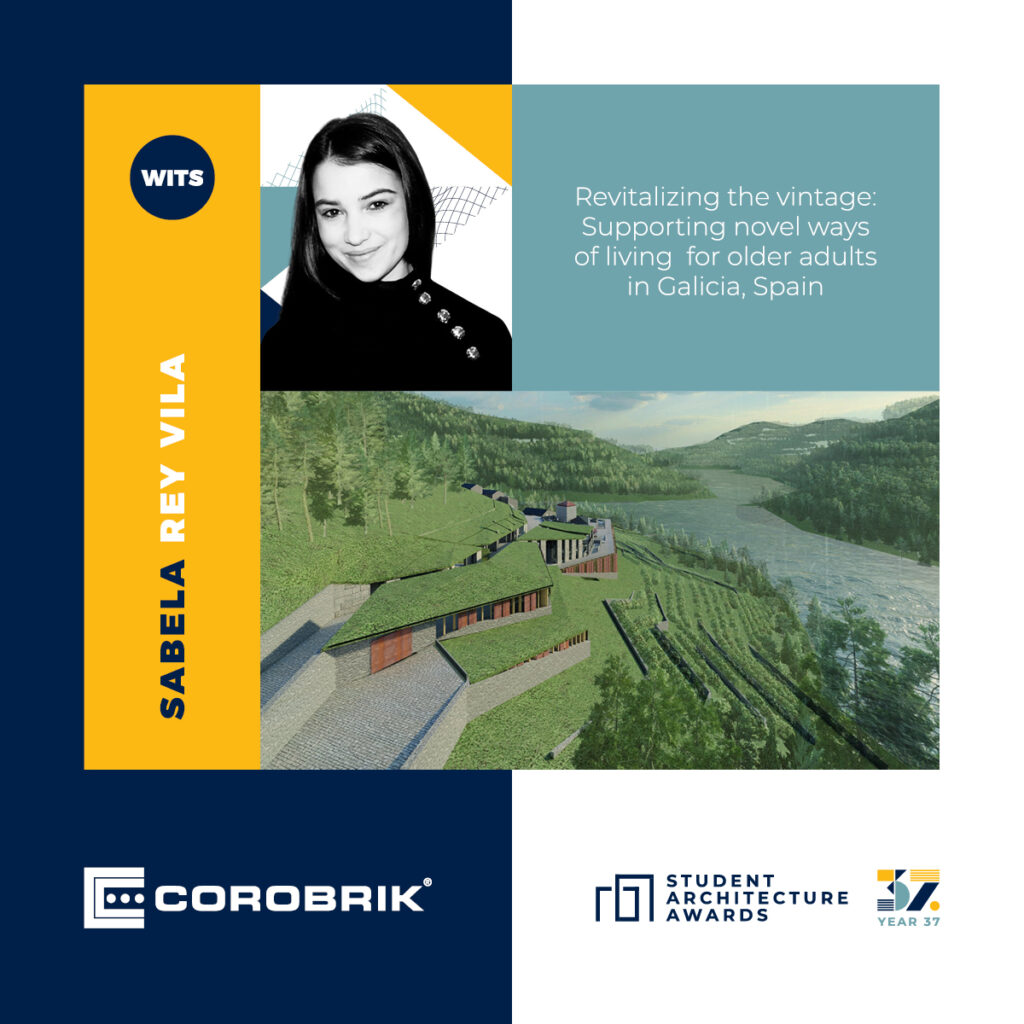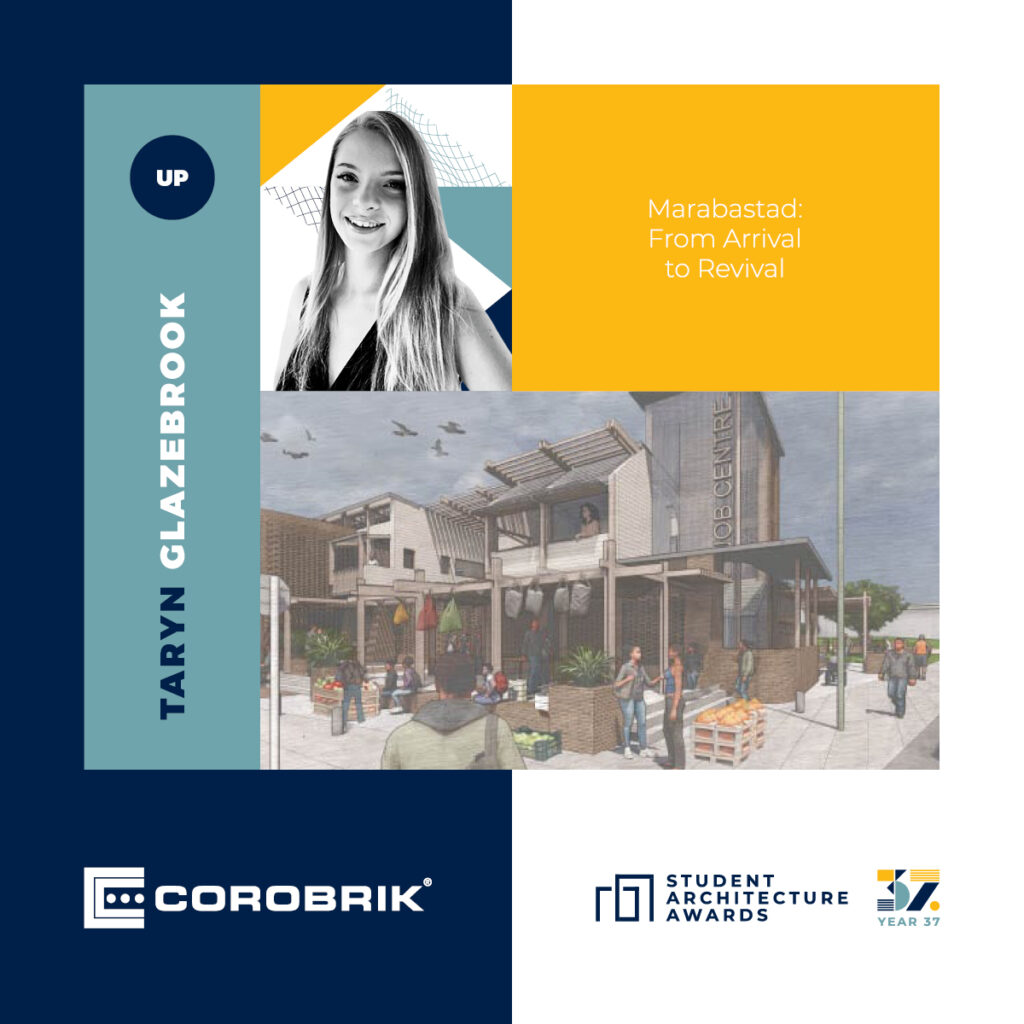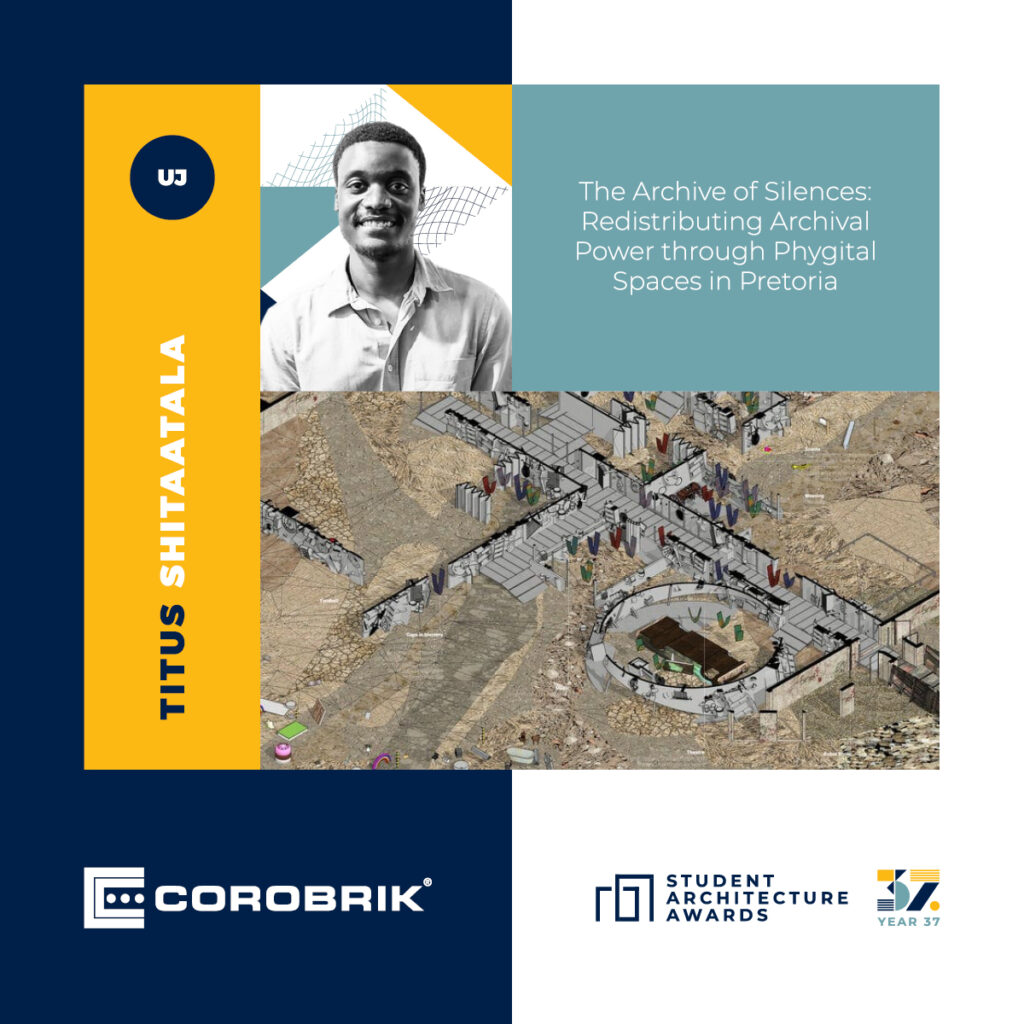Leading brickmaker Corobrik continues to enrich the architectural profession with its annual Student Architecture Awards. Now in its 37th year, the Awards is an ideal platform for up-and-coming architects to set the trends for tomorrow, comments Corobrik CEO Nick Booth. Since 1986, the awards have placed 36 winners on the architectural map, both in leading practices as well as their own firms.
Highlighting talent, creativity, innovation and inspiration, the Corobrik Student Architecture Awards is all about jump-starting careers, building the industry, and designing tomorrow, says Corobrik Marketing Support Manager Thilo Sidambaram, who has been involved with the Awards for over three decades.
The finalists are selected from the eight major universities, based on the students’ Architectural Master’s theses from the class of 2023. This year’s judges were Carin Smuts from CS Studio, Somers Govender from Artek 4 Architects and Rudolf Roos from HDG Pretoria. The finalists each received a R12 000 prize and the opportunity to compete for the top title, plus a R70 000 grand prize, at a live event on 10 May that will also be streamed.
Taryn Glazebrook, University of Pretoria
Taryn says the Corobrik Student Architecture Awards play a pivotal role in promoting young careers by recognising and rewarding innovative and exceptional architectural designs from students across the country. This recognition not only boosts a young designer’s confidence but also elevates architectural excellence within the local industry by setting high standards, fostering a culture of creativity, and challenging the boundaries of design.
“Being an architect allows me to shape spaces that influence people’s daily lives, fostering community, and enhancing well-being. I believe architecture can empower communities by creating inclusive, functional, and sustainable environments that improve the quality of life for everyone. Through innovative, culturally sensitive design, one can create interventions that stand the test of time and truly leave a lasting impact on a community,” comments Taryn.
Her project, entitled ‘Marabastad: From Arrival to Revival’, highlights the importance of investment in architecture for those most in need, emphasising innovation and sensitivity to context. In South Africa especially, architectural interventions should extend beyond mere structures to address broader societal issues and support marginalised communities.
The project utilised various types of bricks for a range of elements, including seating, ventilated screen walls, chimneys, planters, and more. In addition, pavers were used for façade screening elements to assist with solar control. “The flexibility, modularity, and ease of construction with brick made incorporating it into my project enjoyable; it is not only sustainable, but also offers endless possibilities,” explains Taryn.
As for her future plans, she looks forward to fully immersing herself in the architectural industry and finding her place in the working world while continuing to develop personally. “I want to travel and explore many different cultures around the world to deepen my worldview and architectural knowledge,” says Taryn.
For online publications only: Click here to view Taryn’s project – Taryn Glazebrook I Finalist 2023 (corobrik.co.za)
Sabela Rey Villa, University of the Witwatersrand
Sabela says the Corobrik Student Architecture Awards serve as an exceptional platform to showcase local talent and create a more robust architectural community. “I believe the Awards inspire students to work hard to achieve this recognition for their work and ultimately become finalists. Such as aspirational environment elevates standards within the student community, creating a collective desire for improvement and excellence,” she comments.
Sabela is passionate about the role architecture plays in shaping our future, particularly its capacity to address social challenges through innovative design thinking. Her project is entitled ‘Revitalising the Vintage: Supporting Novel Ways of Living for Older Adults in Galicia, Spain’. It focuses on enhancing the quality of life for elderly individuals living in isolated areas.
It achieves this by revitalising an abandoned village and transforming it into a satellite community that can serve other small population centres. These remote areas often lack essential services and support systems for ageing residents. “I am motivated by the belief that this segment of society is frequently overlooked. I wanted to explore how architecture, integrated into broader networks of services, can improve their lives,” explains Sabela.
Moreover, these abandoned villages have significant heritage value in local architecture, much of which is in danger of being lost due to neglect. “It was important to me to not only preserve but also showcase this local architectural tradition, ensuring that its knowledge, practicality and beauty endure for future generations,” adds Sabela.
She aspires to integrate practice-based research with academia in her ongoing professional journey. “I am currently exploring the potential of pursuing a PhD while developing my own architectural practice in the in the near future,” she says.
For online publications only: Click here to view Sabela’s project – Sabela Rey Villa I Finalist 2023 (corobrik.co.za)
Kelly De Gouveia, University of Cape Town
Kelly says the Corobrik Student Architecture Awards are “hugely empowering for emerging architects” like herself. “It can be a challenging profession, but these Awards serve as a beacon of encouragement by validating the significance of our ideas and giving us a platform to share them.”
Her project is entitled ‘Crafting Endurance: Form, Time, Space, and Memory in the Construction of a Civic Urban Artefact for Cape Town’s East City’. In researching her key themes of time, memory, and endurance, Kelly says she has come to appreciate the importance of adopting ‘slow’ means of producing architecture.
“My thesis tries to enforce the idea that by embracing deliberate and patient design and construction processes, there is a greater likelihood of producing architecture that is enduring, cherished, and imbued with deeper significance,” she highlights.
Kelly adds that architects have a profound opportunity to make a tangible impact on people’s daily lives. While recognising that architecture alone cannot revolutionise the world, Kelly is inspired by its potential to enact significant change. Even small, incremental, carefully crafted interventions can lead to substantial enhancements in the quality of life for individuals and communities.
Commenting on the use of brick in her project, Kelly points out that it is a conventional material that almost everyone has some form of association with. It is affordable, long-lasting, and requires very little maintenance, making it a sustainable material choice. Kelly’s proposed design uses concrete as the primary material and incorporates moments of artisanal clay brick detailing to evoke a sense of familiarity and memory into the otherwise heavy, dominating concrete structure.
Kelly is currently undertaking an internship at Shigeru Ban Architects in Paris, where she is discovering a new world of possibilities in architecture and design previously unknown to her. “My goal is to absorb as much knowledge as possible before returning to South Africa, where I intend to apply the valuable lessons I have gained along the way,” she says.
For online publications only: Click here to view Kelly’s project – Kelly De Gouveia I Finalist 2023 (corobrik.co.za)
Arran Wood, University of the Free State
Arran says the Corobrik Student Architecture Awards highlight the hard work students put into their thesis projects. “It can possibly spark interesting topics of conversation around architectural ideas. “The possibility of art between people and place is what is truly inspiring about architecture. Creating forms that can be the expression between people, concepts, and landscapes is fascinating to me,” he comments.
“Our hands are tools of communication. The things I create with my hands are how I communicate what I understand my world to be. I design to express the things I cannot with words. Every small thing I craft tells a piece of my story. To me, design has and always will be a part of my life. I know this is the right path I have chosen to walk, no matter the challenges. That is why I study architecture,” explains Arran.
Arran says that being able to contribute to the historic record of South Africa’s nuclear weapons programme in a small way and highlight forgotten history was very important to him in his thesis, entitled ‘Spectral Flesh – Remembrance’. It was a goal that the thesis become a small part of history itself by documenting South Africa’s nuclear arms development during the Angola South African War.
“I am very passionate about my home country and hope to contribute to the built environment of South Africa,” says Arran. “I would like to thank all the people who have supported me through this journey: my lecturers, classmates, parents, and my wife. Most of all, I would like to thank my Creator for giving me the ability to achieve and opening impossible doors for the completion of my thesis.”
For online publications only: Click here to view Arran’s project – Arran Wood I Finalist 2023 (corobrik.co.za)
Gideon Williams, Nelson Mandela University
Gideon says he loves exploring ideas and concepts, dreams, and whims. “I love the attempt at representation: graphical, sketched, rendered, or simply observed. I also love physical objects, things that are interesting to be around, under, inside of, or on top of.
“To be frank, I never chose architecture as a career choice, but architecture is a field that encapsulates everything I find fascinating. Architecture somehow amalgamates all my diverging interests and passions,” explains Gideon.
‘The Design of an Archive at King’s Beach, Gqeberha’ invents “a useless, idiotic, whimsical architecture that houses all the unwanted and unrepresented objects in the city, giving the voiceless a platform to scream,” explains Gideon. “Architecture should be fearless and true.”
“I am inspired by the potential of radically creative design ideas implemented on a practical scale where it directly and personally improves the spaces people inhabit. I also find the potentiality of recycling materials and reusing built structures and objects exciting,” says Gideon. He adds that the Corobrik Student Architecture Awards encourages students to strive for excellence beyond the walls of the university.
For online publications only: Click here to view Gideon’s project – Gideon Williams I Finalist 2023 (corobrik.co.za)
Gareth Calvert, University of KwaZulu-Natal
Gareth says the Corobrik Student Architecture Awards significantly highlight the efforts of the individual finalists. Furthermore, it provides a platform for these young architects to promote their achievements and for established architectural practices to employ top talent within the architectural field.
“The ability of the built environment to contribute positively to the user’s psychological and emotional well-being inspires me. Well-designed architecture can enhance community spirit. A community with a positive self-identity will feel a sense of inclusion within that community, ultimately improving the quality of life for all members,” explains Gareth.
His project, ‘An Exploration of Childhood Attention Deficit Hyperactivity Disorder Through Architecture: Towards an Inclusive Education Facility in Greater Durban’, uses Corobrik’s Country Classic Satin facebrick on all the various buildings throughout the school’s design.
Besides the sustainable aspect of incorporating this brick, using natural materials such as clay relates to Gareth’s research findings. Incorporating clay facebrick throughout his design linked the architectural language of the various buildings and limited the need for costly maintenance throughout the lifecycle of the project.
He plans to become involved in educational architectural projects by implementing what he has learnt, focusing more on inclusivity from inception to completion. “If you love what you do, keep progressing and growing in that field, and never settle, there is always more to learn – enjoy the journey,” says Gareth.
For online publications only: Click here to view Gareth’s project – Gareth Calvert I Finalist 2023 (corobrik.co.za)
Titus Shitaatala, University of Johannesburg
With the definition and role of the architect constantly changing, Titus says the Corobrik Student Architecture Awards recognise young practitioners as the dynamic shapers of future local architecture, while showing appreciation and encouraging unique perspectives.
‘The Archive of Silences: Redistributing Archival Power through Phygital Spaces in Pretoria’ empowers communities to write their own stories and record their own histories spatially through the construction of their archive. The archive then systematically decays to empower future generations to write their narratives as well through reconstruction.
Using Marabastad as a site, Titus looked at a range of clay bricks being used in the community. The patterns, colours, and usage of the bricks saw them carry the memory and identities of the residents. Sustainably, like other items in the community, the bricks are repurposed by generations in a speculative future to reflect their own identities which were undoubtedly shaped by the memories of these past residents.
“I enjoy architecture’s ability to form interrelationships with other fields. Often these bring up a wider array of creative solutions to spatial problems, be it in sustainability, environmental impact, user experience, or cultural preservation. As a result of these solutions, communities can thrive, and quality of life is enhanced,” says Titus.
He plans on growing his skills and knowledge as an architect while also practicing as a visual artist to create speculative spatial landscapes and narratives in Southern Africa. “My interest in art and architecture sparks curiosity in the future Southern Africa. I also hope to get into digital and physical set design someday,” says Titus.
For online publications only: Click here to view Titus’s project – Titus Shitaatala I Finalist 2023 (corobrik.co.za)
Letlhogonolo Sesana, Tshwane University of Technology
Letlhogonolo says the Corobrik Student Architecture Awards serve as a beacon for recognising emerging talent, promoting opportunities for networking, mentorship, and collaboration with established firms, and nurturing architectural excellence in the local industry. Winning such accolades enhances reputation and contributes to the sharing and preservation of architectural knowledge by showcasing exemplary projects and inspiring others in the field.
‘Investigating Architecture’s Role in Preserving South African Birth Rituals’ delves into the intersection of selfhood, spirituality, and space in African contexts, enriching architectural discourse by exploring the role of architecture in preserving birth rituals amid cultural erosion in South Africa. It emphasises ritual, liminality, scale, site, materiality, and user experience, drawing from African philosophies of identity and scale.
“What inspires me about being an architect is the opportunity to shape the built environment and enhance the quality of life for all. Architecture is a medium through which I have grown into my essence. It supports communities in confronting histories, shaping new narratives, collectively healing, and projecting new possibilities for the future,” says Letlhogonolo.
Looking ahead, Letlhogonolo is eager to continue his journey as an architect by pursuing opportunities that allow him to further refine his skills, expand his knowledge, and make meaningful contributions to the built environment. “Whether through professional practice, further academic research, or community engagement initiatives, he aspires to mentor and inspire the next generation of architects, designers, and makers, fostering a culture of innovation, inclusivity, and sustainability within the profession,” says Letlhogonolo.
As she embarks on the next phase of her career, Letlhogonolo is excited to continue pushing the boundaries of design, advocating for positive change, and contributing to the advancement of architectural practice and theory. “I extend my heartfelt gratitude to all who contributed to the exploration, interrogation, making, and investigation of my study,” she says.

